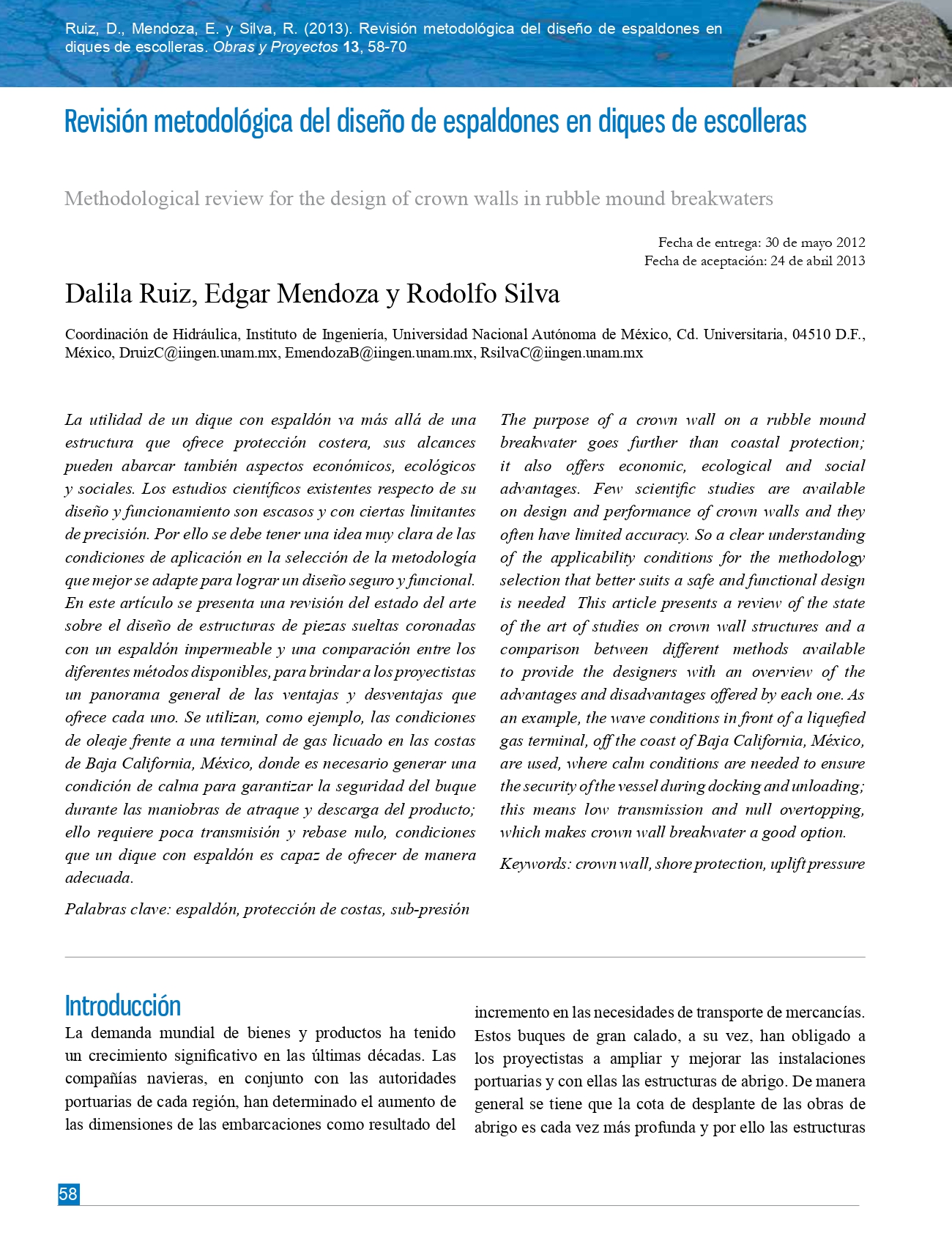Methodological review for the design of crown walls in rubble mound breakwaters
DOI:
https://doi.org/10.4067/S0718-28132013000100006Keywords:
crown wall, shore protection, uplift pressureAbstract
The purpose of a crown wall on a rubble mound breakwater goes further than coastal protection; it also offers economic, ecological and social advantages. Few scientific studies are available on design and performance of crown walls and they often have limited accuracy. So a clear understanding of the applicability conditions for the methodology selection that better suits a safe and functional design is needed This article presents a review of the state of the art of studies on crown wall structures and a comparison between different methods available to provide the designers with an overview of the advantages and disadvantages offered by each one. As an example, the wave conditions in front of a liquefied gas terminal, off the coast of Baja California, México, are used, where calm conditions are needed to ensure the security of the vessel during docking and unloading; this means low transmission and null overtopping, which makes crown wall breakwater a good option.
References
Bradbury, A.P.N, Allsop, N.H.W and Stevens, R.V (1988) Hydraulic performance of breakwater crown walls. Hydraulic Research, Wallingford, Report SR146.
Camus, P.B. and Guillén, J.G. (2004). Wave forces on crown walls: Evaluation of existing empirical formulations. Proceedings of 29th Conference on Coastal Engineering, Lisboa, Portugal.
Günbak, A. R. and Gökce, T. (1984). Wave screen stability of rubble-mound breakwaters. International Symposium of Maritime Structures in the Mediterranean Sea. Athens, Greece.
Iribarren, R. y Nogales, C. (1964). Obras marítimas. Ed. Dossat, Madrid.
Jensen, O. (1984) A monograph on rubble mound breakwaters. Danish Hydraulic Institute. Denmark.
Li, X., Ren, B., Wang, G.Y. and Wang, Y. (2011). Numerical simulation of hydrodynamic characteristics on an arc crown wall using volume of fluid method based on BFC. Journal of Hydrodynamics 23(6), 767-776. https://doi.org/10.1016/S1001-6058(10)60175-8
Losada, M.A. and Giménez-Curto, L.A. (1981). Flow characteristics on rough, permeable slopes under wave action. Coastal Engineering 4, 187-206. https://doi.org/10.1016/0378-3839(80)90019-8
Martin, F.L., Losada, M.A. and Medina, R. (1999). Wave loads on rubble mound breakwater crown walls. Coastal Engineering 37(2), 149-174. https://doi.org/10.1016/S0378-3839(99)00019-8
Martin, F.L., Vidal, C., Losada, I. and Martínez, C.L. (2000). Scale effects on scale tests on crown walls. Proceedings of 27th International Conference on Coastal Engineering (ICCE), Ed. Billy Edge (ASCE), Sydney, Australia, 1696-1710.
Nagai, S. (1973). Wave forces on structures. Advances in Hydroscience, Vol. 9. Academic Press, New York, 253-324. https://doi.org/10.1016/B978-0-12-021809-7.50011-0
Pedersen, J. (1996). Experimental study of wave forces and overtopping on crown walls of rubble mound breakwaters. Series paper 12, HC Engineering Laboratory, Department of Civil Engineering, Aalborg University, Denmark.
Pedersen, J. and Burcharth, H.F. (1992). Wave forces on crown walls. Proceedings of 23th Conference on Coastal Engineering, Venecia, Italia, 1489-1502.
Takahashi, S., Kotake, Y., Fujiwra, R. and Isobe, M. (2002). Performance evaluation of perforated-wall caissons by VOF numerical simulations. Proceedings of the 28th Coastal Engineering Conference, Cardiff, 1364-1376.
Torum, A., Moghim, M.N., Westeng, K., Hidayati, N. and Arntsen, O. (2012). On berm breakwaters: Recession, crown wall wave forces, reliability. Coastal Engineering 60, 299-318. https://doi.org/10.1016/j.coastaleng.2011.11.003

Downloads
Published
Issue
Section
License
Copyright (c) 2013 Universidad Católica de la Santísima Concepción

This work is licensed under a Creative Commons Attribution-NonCommercial 4.0 International License.







